Hello,
How Can We Help You?
Contact Form
Fill in the form and we will contact you as quickly as possible.
Contact us on Whatsapp
Scan with your camera app or click the QR code to start a conversation.
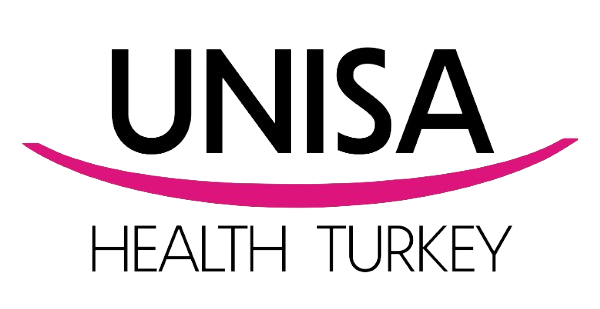
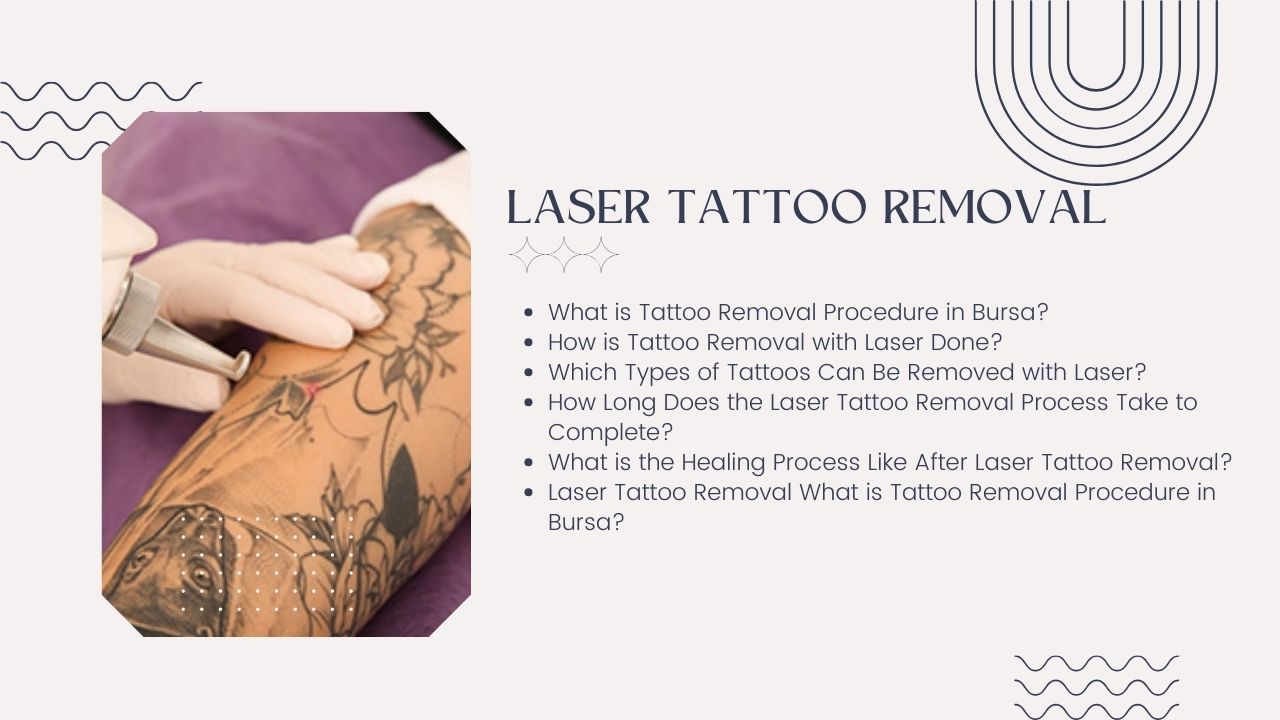
What is Tattoo Removal Procedure in Bursa?
How is Tattoo Removal with Laser Done?
Which Types of Tattoos Can Be Removed with Laser?
How Long Does the Laser Tattoo Removal Process Take to Complete?
What is the Healing Process Like After Laser Tattoo Removal?
Laser Tattoo Removal What is Tattoo Removal Procedure in Bursa?
How is Tattoo Removal with Laser Done?
Tattoo removal with laser is performed using specialized laser devices and is usually carried out by expert dermatologists or plastic surgeons. The procedure typically consists of several steps:
Consultation: Prior to the procedure, a consultation meeting is held with the patient. During this meeting, the patient is informed about the details of the tattoo removal procedure, expectations, and potential risks. Factors such as the size, color, and skin type of the tattoo are also evaluated.
Skin Preparation: On the day of the procedure, the tattoo removal area is cleaned and sterilized. This step is important to reduce the risk of any infection on the skin.
Application of Anesthesia (Optional): Local anesthetic cream or cold air may be applied during the procedure to reduce pain. This can help minimize discomfort during the procedure.
Laser Application: The tattoo removal procedure is performed using specialized laser devices. Laser light removes the tattoo pigments from the skin by breaking them down. The laser beam is adjusted based on the size of the tattoo, its color, and the skin type.
Cooling and Healing: During the laser procedure, the skin can be protected with cooling devices or cold air. This can help reduce any side effects on the skin and accelerate post-procedure healing. After the procedure, the skin may experience slight redness or swelling, but these symptoms typically diminish within a few days.
Follow-up Checks: Regular follow-up checks after the procedure are important to monitor the healing process of the skin and provide additional treatment or care if needed. Multiple laser sessions may be required, so the patient is regularly monitored.
Tattoo removal with laser can vary depending on the size of the tattoo, its color, and the skin type. Additionally, side effects such as mild redness, swelling, or temporary pigment changes may occur on the skin after the procedure. Therefore, it is important for individuals with tattoos to consult a dermatologist or a specialized healthcare professional before undergoing tattoo removal. A specialist can assess the individual's condition and guide them through the process.
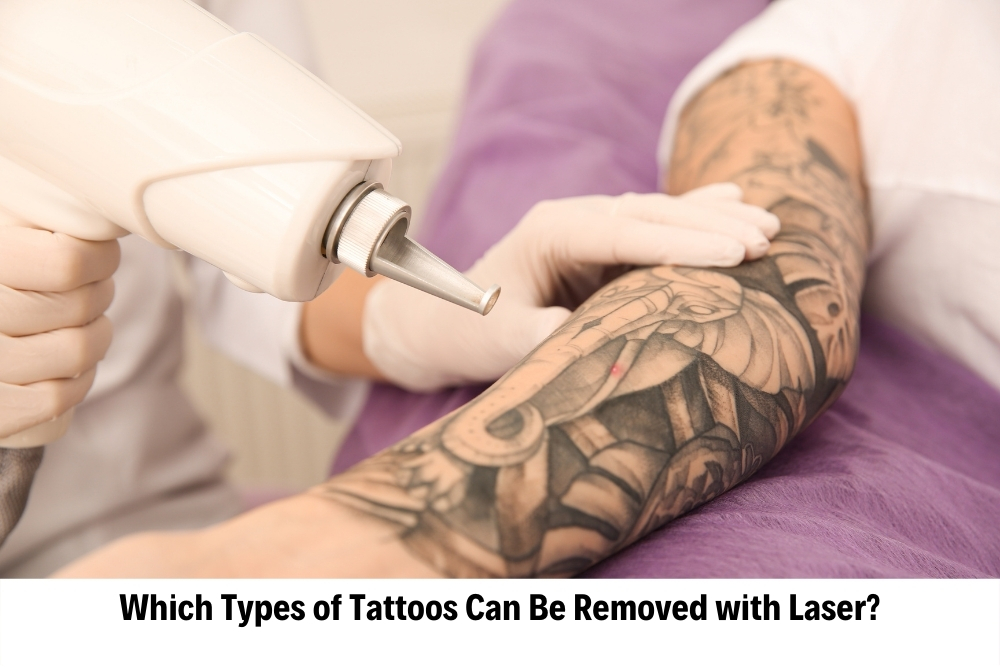
Laser tattoo removal is an effective method for reducing or completely removing various types of tattoos. However, the process of completely removing or reducing tattoos from the skin depends on the characteristics of the tattoo. Here are some common types of tattoos that can be removed with laser:
Black Ink Tattoos: Tattoos made with black ink are often the easiest to remove because black ink enhances the absorption of laser light.
Colorful Tattoos: Removing colorful tattoos is a bit more complex because different colors require different wavelengths of laser light. However, with modern laser technology, many colorful tattoos can be effectively reduced or removed.
Professional Tattoos: Tattoos done by professional tattoo artists may be deeper and denser. Removing these tattoos may be a bit more challenging, but they can still be effectively reduced or removed with laser treatment.
Amateur Tattoos: Tattoos done at home or in non-professional settings are typically lighter and more superficial. These tattoos are usually easier to remove because the pigments are placed in the upper layers of the skin.
Small Tattoos: Small tattoos are often easier to remove and may require fewer sessions for removal. However, depending on the type of tattoo, even small tattoos may require multiple sessions.
The laser tattoo removal process can vary depending on the size, color, skin type, and depth of the tattoo. Additionally, side effects such as mild redness, swelling, or temporary pigment changes may occur on the skin. Therefore, it is important for individuals with tattoos to consult a dermatologist or a specialized healthcare professional before undergoing tattoo removal. A specialist can assess the individual's tattoo and skin characteristics and determine the most suitable treatment plan, guiding them through the process.
The completion time of the laser tattoo removal process can vary depending on several factors and may differ for each patient. These factors include the size, color, skin type, and depth of the tattoo.
Small and less complex tattoos can usually be completed in a shorter time, while removing larger and more complex tattoos may take longer. Additionally, the color of the tattoo can also affect the duration. For example, black ink tattoos are typically removed more quickly, while removing colorful tattoos may take longer because different colors require different wavelengths of laser light.
Generally, each session of laser tattoo removal lasts between 15 to 30 minutes. However, multiple sessions are usually required to achieve complete results. These sessions are typically repeated at intervals of several weeks or months. Depending on the size, color, and skin type, an average of 5 to 10 sessions may be required for a patient.
There is a need for healing time between each session, so sessions are usually scheduled at specific intervals. The healing process involves the skin absorbing and eliminating the tattoo pigments over time. This process can vary depending on the size and depth of the tattoo.
In conclusion, the completion time of the laser tattoo removal process varies from person to person and depends on the characteristics of the tattoo. An expert dermatologist or plastic surgeon evaluates the individual's condition and determines the most appropriate treatment plan for laser tattoo removal, guiding them through the process.
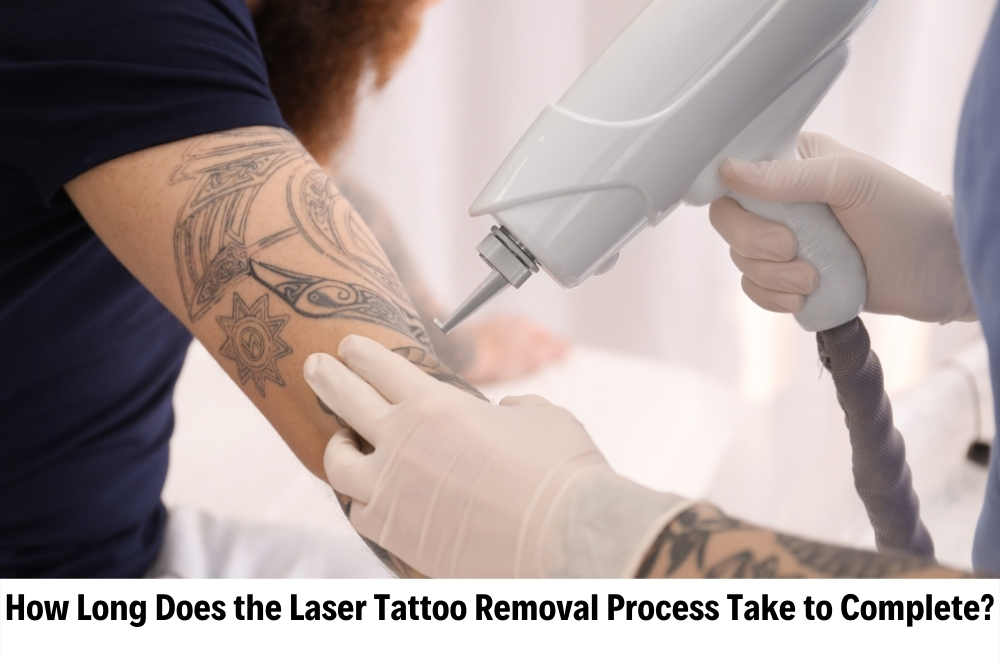
The healing process after laser tattoo removal can vary depending on the individual's skin type, the size of the tattoo, and the laser technology used during the procedure. However, it generally involves the following steps:
Mild Redness and Swelling: After the procedure, there may be mild redness and swellingin the areas where the laser was applied. This is a normal reaction and typically subsides within a few hours.
Peeling and Crusting: Within a few days after the procedure, the skin may start to peel or crust. This is part of the natural healing process as the top layer of the skin sheds, revealing new skin underneath. It is important not to pick or scratch at the peeling skin to avoid scarring or infection.
Sensitivity: Some sensitivity may be experienced in the treated areas after the procedure. This sensitivity is a normal part of the healing process and usually diminishes within a few days.
Itching: Itching may occur during the healing process. It is important to resist the urge to scratch the treated areas as this can disrupt the healing process and potentially lead to complications.
Avoiding Sun Exposure: It is important to avoid sun exposure to the treated areas during the healing process. Sun exposure can cause irritation and may increase the risk of complications such as hyperpigmentation or scarring. It is recommended to keep the treated areas covered and use sunscreen if going outside.
Moisturizing and Care: Keeping the treated areas moisturized and following a proper skincare routine can help promote healing. Using gentle moisturizers and avoiding harsh chemicals or abrasive skincare products can help prevent irritation.
Doctor Follow-ups: Regular follow-up appointments with the doctor are important during the healing process. The doctor will monitor the progress of healing and may recommend additional treatments or adjustments as needed.
Overall, the healing process after laser tattoo removal is usually quick and straightforward. However, individual experiences may vary, and it is important to follow the doctor's instructions for optimal results and to minimize the risk of complications. If any unusual symptoms or concerns arise during the healing process, it is important to contact the doctor for guidance and assistance.
Lorem ipsum dolor sit amet consectetur adipisicing elit. Mollitia accusantium, quod quasi iusto soluta sed.
Treatments are carried out in contracted healthcare institutions that hold a Health Tourism Authorization Certificate.
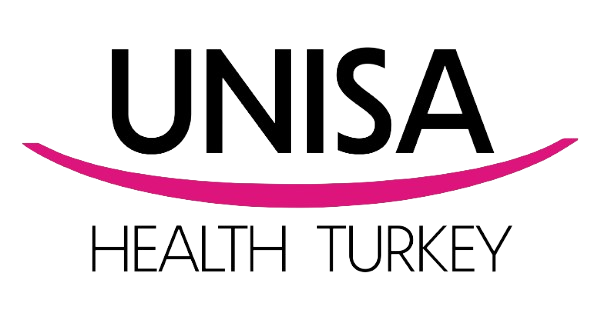
Unisa Health Turkey aims to grow in the light of science and knowledge by developing with its friendly team that adopts ethical values based on the satisfaction and health of patients and their relatives with quality accommodation and transportation services in the health tourism sector, which it leads as a vision.
+90 (224) 222 0 221 +90 532 727 36 99 24/7 ContactUlu Mh. Esen Sk. Nilsaş İş Hanı Sitesi No:1/B | Osmangazi / BURSA-TURKEY
+90 532 727 36 99 24/7 Contact
Monday - Friday (09:30 - 19:00)
Saturday (10:00 - 19:00)
In order for Unisa Health Turkey to carry out the services we will provide to you, we may need to learn your personal information and health data and record and store them within the limits required by the service to be provided.
The health data we are required to record in order to provide health services to you are legally considered special categories of personal data. In this context, according to Article 6, Paragraph 2 of the Personal Data Protection Law No. 6698, "Processing of special categories of personal data without explicit consent of the data subject is prohibited," personal health data can only be recorded with the explicit written consent of the individual, except in special cases specified by law. Therefore, it has become necessary to obtain this explicit consent from you.
This text covers the personal data you provide to us verbally, in writing, visually, or electronically during your visit to our clinic, as well as the personal data you submit to us via internet and mobile applications or electronically, or that are obtained in our clinic (test results, prescriptions, photos, etc.). In this context, the personal health data necessary for the execution of the services we will provide to you, including your name, surname, Turkish ID number (or your passport number or temporary Turkish ID number if you are not a Turkish citizen), place and date of birth, marital status, gender information, identity data, various identification documents, address, phone number, email address, financial data such as your bank account number and IBAN number, medical history in your clinical file, information showing your disease history, examination data, data regarding the procedures performed on you, prescription information, your photos, all kinds of images, audio/video recordings, laboratory and imaging results, test results, health and sexual life data obtained during the execution of medical diagnosis, treatment, and care services, data related to private health insurance, and Social Security Institution data are considered personal data.
Your personal data included in the aforementioned data categories will be processed for the purposes of “Conducting Emergency Management Processes, Conducting Activities in Compliance with Legislation, Conducting Finance and Accounting Affairs, Ensuring Physical Space Security, Conducting Legal Affairs, Conducting Communication Activities, Conducting Business Activities / Audits, Conducting Occupational Health / Safety Activities, Conducting After-Sales Support Services for Goods / Services, Conducting Sales Processes for Goods / Services, Conducting Production and Operation Processes for Goods / Services, Conducting Customer Relationship Management Processes, Conducting Activities for Customer Satisfaction, Organization and Event Management, Conducting Storage and Archive Activities, Conducting Contract Processes, Follow-up of Requests / Complaints, Providing Information to Authorized Persons, Institutions, and Organizations, Creating and Tracking Visitor Records.”
These personal data will be recorded within the scope of the Personal Data Protection Law No. 6698 and relevant legislation only to the extent required by the health service to be provided to you and will be stored in our system/archive for a period not exceeding the general statute of limitations of 10 years ‘as long as necessary for the purposes of recording’. Your data processed in this context will be protected as professional secrets, confidentiality will be ensured, and will only be shared with the Ministry of Health (Examination Information Management System), Ministry of Finance, Ministry of Justice, and other government institutions and organizations in accordance with existing laws and regulations, and only to the extent of the requested data when officially requested. Additionally, if your treatment is to be carried out in a hospital, your personal data will be shared with the relevant hospital. They will not be shared with other third parties/institutions/organizations.
However, in cases where the confidentiality of personal medical records must be limited to protect public health, such as the obligation to report infectious diseases to the competent authorities as regulated in Article 58 of the Public Health Law No. 1593, or in cases of legal obligations such as the obligation to report crimes, we remind you that personal medical records may need to be notified to the competent authorities in a limited and proportionate manner for the purpose.
During the course of your diagnosis and treatment, all audio and video recordings, photos, and laboratory information recorded by us may be used anonymously in scientific meetings, scientific publications, patient information, interviews, and correspondence, provided your identity remains confidential.
(It has been informed that this right can be exercised by personally applying or in writing to our clinic located at Barbaros Mahallesi Ihlamur Bulvarı Sarkaç Sokak Ağaoğlu My Prestige Business Center No:1 Floor:2 Apartment:9-10, 34746 Ataşehir/Istanbul.)
By ticking the KVKK box in the communication form on our website or through our email address, you acknowledge that the communication you make is not encrypted and not entirely secure, that your personal information may be intercepted by unauthorized persons, and that you accept all the above-mentioned issues and cannot hold Unisa Health Turkey responsible for this.
I have read and understood the Personal Data Information and Express Consent Text prepared by Unisa Health Turkey,
I have been informed about the purposes, collection methods, and legal reasons for processing my personal data, my rights regarding the protection of my personal data, the obligatory cases for the transfer of my data, data security, and my application rights, which are detailed in the Personal Data Information and Express Consent Text,
I give my explicit consent to the recording, storage, and sharing of all my personal data, including my health data, by Unisa Health Turkey and its employees within the scope of the principles mentioned above,
I also give my explicit consent to the sharing of my data for consultation purposes with colleagues of my doctor or with product supplier companies in cases where the purchase of a special product for me is required,
In addition, I ACCEPT WITH MY EXPRESS CONSENT that Unisa Health Turkey may contact me via mobile devices, internet, or postal mail.
We use cookies to improve your experience on our site. You can manage your preferences in the settings.
Here you can customize your cookie preferences:
Contact Form
Fill in the form and we will contact you as quickly as possible.
Contact us on Whatsapp
Scan with your camera app or click the QR code to start a conversation.

